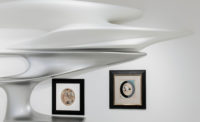The annual London Design Festival (September 13-21) is an epic platform for designers and manufacturers to showcase their new products at concurrent mini-trade fairs around town. This year’s lineup includes 100% Design, Designjunction, and Decorex International, among many others. Throughout the city, however, there will also be discussions, exhibitions, architectural installations—from a digitally-manufactured house to an enormous new Zaha Hadid sculpture—and many more diversions for the design fan. We’ve rounded up a handful of highlights below.
WikiHouse 4.0, September 13–21
Pushing forward into the digital future of construction, ARUP and the architects, designers, and programmers of collaborative studio Zero zero have created plans for what they’re calling the WikiHouse, an “open-source, digitally manufactured, two-story” building for anyone to download, CNC-mill, and assemble. The design team intends to erect their first home in Central London in real time during the festival, for which they’ll offer two interior tours daily. The Building Centre, Store Street South Crescent, 26 Store Street
Zaha Hadid’s Crest Pavilion, September 13–21
Ahead of the 2016 opening of her ME Dubai Hotel, Hadid offers potential guests a preview of what it has in store. At the Victoria and Albert Museum, she’s installing the Crest Pavilion, a sculptural expanse of thin, polished aluminum to float over the John Madejski Garden pond and reflect the sky above and rippling water below. Eventually, the pavilion will be demounted and shipped to the Emirates, but in the meantime, it shows “the relationships between fluid and cartesian, solid and void, surface and structure inherent within the hotel’s design,” according to the firm. Victoria & Albert Museum, Cromwell Road
David Lynch’s “Lost Highway,” September 13
The architectural details of a David Lynch film — the dystopian urbanism of “Eraserheads,” for example — are an essential part of the director’s surreal, noirish universe, and “anxious, absurd and utterly distinct,” according to The Architecture of David Lynch author Richard Martin. During the festival, Martin hosts a screening of “Lost Highway” to search for deeper meaning in the 1997 thriller, using the film’s design elements as clues. Victoria & Albert Museum Lydia & Manfred Gorvy Lecture Theatre, Cromwell Road
“Restless Futures,” September 13–20
“Restless Futures” is a 12-month Central Saint Martins program that examines the evolution of design under currently advancing technologies, and the inherently social, economic, and political consequences. During the festival, recent graduates demonstrate their own predictions of these outcomes through “live installations, performances, and interactive exhibits.” They’ll be on hand to explain their personal takes on what’s yet to come, which includes responsive architectural textiles, open-source carpentry tools, and edible lace. Central Saint Martins, 1 Granary Square
“A Place Called Home,” September 18–21
The Uber of vacation homes, Airbnb, commissioned four design studios—Jasper Morrison, Raw Edges, Ilse Crawford, and Patternity—to create 24-hour fun houses in the middle of Trafalgar Square, solely for the amusement of LDF-goers. Morrison, thinking of the site’s existing winged tenants, tailored his design to suit the needs of an avid pigeon watcher, “because who else would choose to live in the middle of Trafalgar Square?” Trafalgar Square







Post a comment to this article
Report Abusive Comment